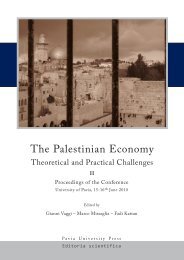Musica che affronta il silenzio - Scritti su Toru Takemitsu - Pavia ...
Musica che affronta il silenzio - Scritti su Toru Takemitsu - Pavia ...
Musica che affronta il silenzio - Scritti su Toru Takemitsu - Pavia ...
Create successful ePaper yourself
Turn your PDF publications into a flip-book with our unique Google optimized e-Paper software.
120<br />
Luciana Galliano<br />
Japan Mutual Security Treaty), a movement of young people and intellectuals opposed to the<br />
renewal and m<strong>il</strong>itarist revision of the Japanese-American agreements (Packard 1966). This<br />
movement took a stand against the deployment of any more American troops on Japanese<br />
territory and also, especially after the war in Korea, any expansion of the American m<strong>il</strong>itary<br />
presence on Japanese so<strong>il</strong>. Its demonstrations were so violent that in late 1960 President Eisenhower<br />
was obliged to cancel a visit to Japan for the signing of the treaty. A group of<br />
ANPO intellectuals, including Takemit<strong>su</strong>, formed the association Wakai Nihon no Kai (Association<br />
of Young Japan).<br />
The climate of social and artistic activism which characterised the decade is reflected<br />
in the character of Takemit<strong>su</strong>’s compositions. His poetical and musical sensib<strong>il</strong>ity was considerably<br />
heightened; the 1960s were <strong>su</strong>rely one of his most creative periods, when some of<br />
his masterpieces saw the light of day. In this period Takemit<strong>su</strong> found himself part of a<br />
group of composers named Sakkyokkashdan, once again through Hayasaka, a group which<br />
was responsible for the important experience of the “Sget<strong>su</strong> Contemporary Series”. The<br />
Sget<strong>su</strong> cultural association was founded as a spontaneous expression of the joyful creativity<br />
and munificence of the Teshigahara fam<strong>il</strong>y, who had set up a modern school of ikebana.<br />
The four sections of the association, inaugurated on 19 November 1958, featured cinema,<br />
video and electronics, music, and theatre, as well as the ikebana school. In the first concert,<br />
held the following <strong>su</strong>mmer, the pianist Takahiro Sonoda, recently returned from Berlin,<br />
played pieces by Schönberg, Webern, Moroi, Yuasa and others on a red Bösendorfer designed<br />
by Norbert Schlesinger. A <strong>su</strong>bsequent concert in Apr<strong>il</strong> 1960 featured two works by<br />
Takemit<strong>su</strong>, the electroacoustic Mizu no kyoku (Water Music) composed in the studios at<br />
Sget<strong>su</strong>, and Sora, uma soshite shi (Sky, Horse and Death, 1957-8). 7 In the same concert<br />
Hisao Kanze performed a noh dance staged by Teshigahara with lighting by Naot<strong>su</strong>gu Imai.<br />
This noh dance, like the works by Mamiya Michio in another concert, the presence of a<br />
giday musician, and indeed the coexistence with an art as profoundly traditional as ikebana,<br />
albeit in a ‘modern’ version like that practised by Teshigahara, all point to a<br />
definitive shift in status of traditional Japanese music and arts in the new cultural climate:<br />
from being a totally separate, vaguely masonic realm, in the 1960s it became a living, fert<strong>il</strong>e<br />
reality. Once again a number of young artists from various backgrounds got together to<br />
collaborate, and Takemit<strong>su</strong> now found himself obliged to confront the artistic forms of his<br />
own culture. In October 1961, after widening the horizon of the ‘traditional’ music he listened<br />
to, he wrote:<br />
7 In 1957, for a commission by the NHK and working in their studios, Takemit<strong>su</strong> composed the piece of<br />
concrete music Aru otoko no shi (Death of a man, the story of B<strong>il</strong>ly the Kid, text by Shuntar Tanikawa).<br />
He rewrote it in 1958, giving it the title Sora, uma soshite shi (Sky, Horse and Death). In 1960 this piece<br />
was used by the group of experimental music Vortex in San Francisco, and also performed at the Sget<strong>su</strong><br />
Hall together with Quiet design. It was given once again in a concert in the first edition of the “Tokyo<br />
Festival of Contemporary Music”.

















